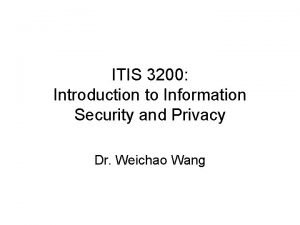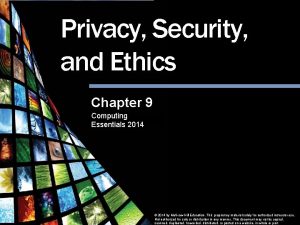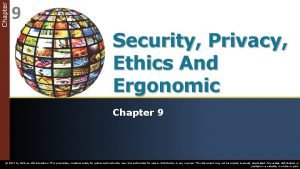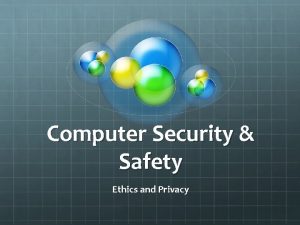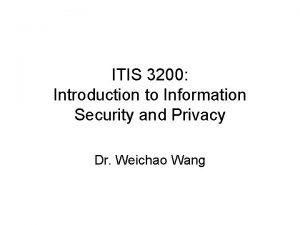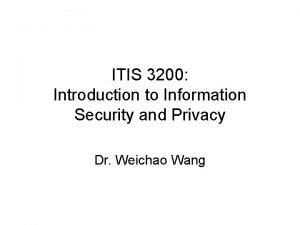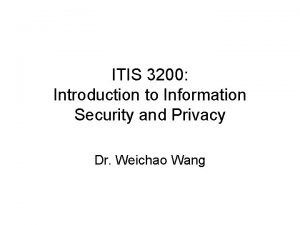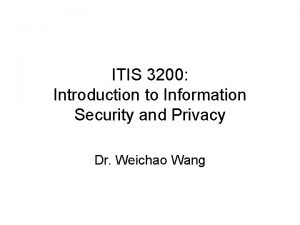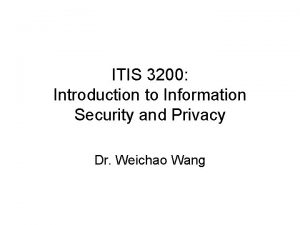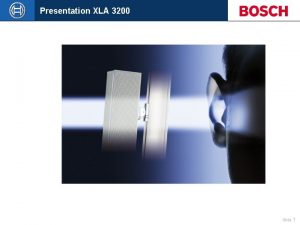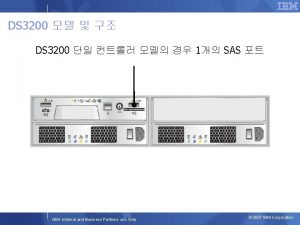ITIS 3200 Introduction to Information Security and Privacy









- Slides: 9

ITIS 3200: Introduction to Information Security and Privacy Dr. Weichao Wang

• Chapter 2: A concrete example: Access Control Matrix – First introduced in OS and databases – Describe allowed access using a matrix – Protection state of the system – Describe the protection state by characterizing rights of each subject over objects. – We are especially interested in state transitions that will affect the protection states.

• Access control matrix model – Objects O: the set of protected entities – Subjects S: the set of active objects that can perform actions (process or user) – Rights R: the full right set. For every pair (s, o), a subset of rights is granted. – The set of protection states is represented by (S, O, A) – Some subjects can also be objects – An example

• Access control matrix model (continued) – The meaning of rights depends on system and objects involved – The access control matrix can model a large system containing multiple machines, or a programming language at the micro level – The matrix can also contain functions to determine rights (mutual access)

• Protection state transitions – Operations will lead to changes of states, and updates in access control matrix • State Xi will change to state X(i+1) under command c(i+1) • A command may have multiple parameters and lead to multiple state transitions (share a folder in a OS)

• Primitive command – Create subject s – Create object o – Enter right r into a[s, o] – Delete right r from a[s, o] – Destroy subject s – Destroy object o

• Primitive commands can be combined into commands – System usually does not directly call primitive commands, but through another level of wrapper – A command invoking only one primitive is called mono-operational command – Conditional commands do not support negation

• Examples of commands Command create-file (p, f) create object f; enter own into a[p, f]; enter read into a[p, f]; enter write into a[p, f]; End // process p creates a file f Command grant-read-file (p, f, q) if r in a[p, f] and owner in a[p, f] then enter r into a[q, f]; end // process p grants read // right on file f to q

• Some concepts that we need to understand: – Protection state and access control matrix – State transition caused by operations and command – Access control matrix is not used directly because of space requirements.
 Itis 3200
Itis 3200 Privacy awareness and hipaa privacy training cvs answers
Privacy awareness and hipaa privacy training cvs answers Microsoft from back doors gov active
Microsoft from back doors gov active Chapter 9 privacy security and ethics
Chapter 9 privacy security and ethics Chapter 9 privacy security and ethics
Chapter 9 privacy security and ethics Chapter 9 privacy security and ethics
Chapter 9 privacy security and ethics Hipaa privacy and security awareness training
Hipaa privacy and security awareness training Computer security safety ethics and privacy
Computer security safety ethics and privacy Private secuirty
Private secuirty Explain about visa international security mode
Explain about visa international security mode
